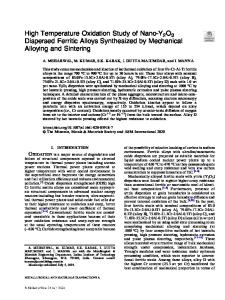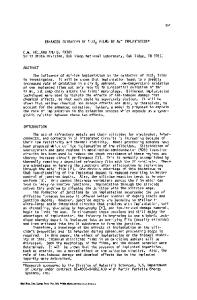Enhanced CO Oxidation Catalysis of Pt0.1Cu0.9/Fe 2 O 3 Synthesized by Radiolytic Process
- PDF / 702,594 Bytes
- 6 Pages / 612 x 792 pts (letter) Page_size
- 3 Downloads / 359 Views
Enhanced CO Oxidation Catalysis of Pt0.1Cu0.9/Fe2O3 Synthesized by Radiolytic Process
Takao A. Yamamoto, Ryota Kitagawa, Satoshi Seino, and Takashi Nakagawa Grad. Sch. Eng., Osaka University, 2-1 Yamadaoka, Suita, Osaka 565-0871, Japan.
ABSTRACT Catalysts in which Pt and Cu are immobilized on support particles of γ-Fe2O3 were synthesized by the radiolytic process and were evaluated for CO oxidation in a gas flow mixture (1% CO, 0.5% O2, 67.2% H2 and N2 balance) by measuring the CO concentration in the outlet gas. The Pt/Cu atomic ratios of the as-synthesized catalysts were determined to be 100:0, 90:10, 78:22, 50:50, 21:79, and 11:89, and the total metal loadings determined by chemical analyses were 10 wt%. Material characterization was performed using X-ray diffraction, X-ray absorption near edge structure, and transmission electron microscopy, and it was indicated that the composite catalysts consist of Pt-Cu bimetallic grains immobilized on the support at higher Pt-loading, while CuO with poor crystallinity is also observed at lower Pt-loading. The catalytic activity decreased as the Pt-loading was decreased to 50 at%, and also with increasing temperature. However, as the Pt-loading was further decreased, the activity contrariwise increased, and increased with increasing temperature up to 100 °C. The sample containing only 11 at% Pt exhibited the highest activity at 100 °C, which is higher than that of the commercial catalyst measured for comparison, and given at a lower temperature than that for the commercial catalyst. This enhanced activity, despite the low Pt-loading, could be attributed to oxygen supply via CuO from the O2-poor atmosphere to PtCu bimetallic grains trapping CO molecules. This new material is promising for use as a catalyst to purify hydrogen gas fed to a polymer electrolyte fuel cell. INTRODUCTION The hydrogen gas supplied to a polymer electrolyte fuel cell (PEFC) should be free from CO, because CO poisons the Pt in the PEFC anode; therefore, reformed hydrogen gas is typically purified using a catalyst that preferentially oxidizes CO [1,2]. Requirements for such a catalyst are lower cost and higher activity, especially in the temperature range suitable for PEFC operation. One attractive route to such advanced catalysis is to enhance the activity by obtaining an appropriate atomic structure formed by Pt and an additional cheaper element, which plays role not only as a mere diluent, but also as an enhancer. We have reported the successful synthesis of Pt-Cu alloy nanoparticles supported on γ-Fe2O3 by the radiolytic process, and the catalytic activity for CO oxidation is enhanced by alloying than pure Pt [3,4]. This new synthesis process is a simple and quick one-pot process in which the source materials are mixed in aqueous solution and irradiated without treatment by heat or other chemicals [5,6]. Radiation-induced radicals reduce aqueous ions very quickly and uniformly in the solution [7], and may produce
alloy nanoparticles, even when two or more metal precursors with different redox pot
Data Loading...











